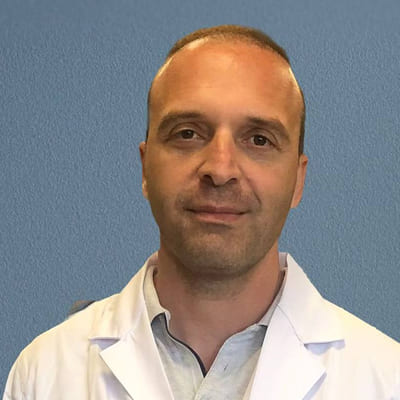
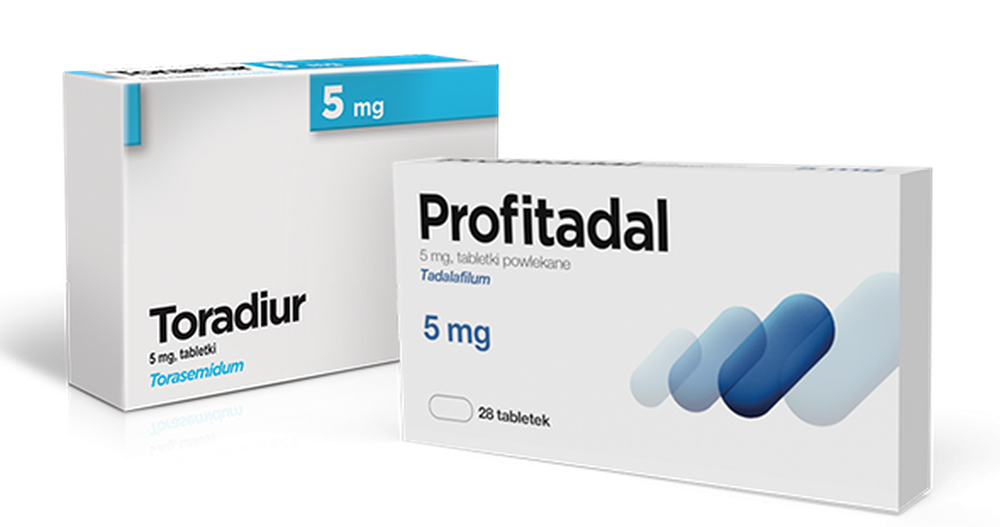
Profitadal

Ask a doctor about a prescription for Profitadal

How to use Profitadal
Leaflet attached to the packaging: information for the user
EMLA PLASTER
25 mg + 25 mg, medicinal plaster
Lidocaine + Prilocaine
Read the leaflet carefully before using the medicine, as it contains important information for the patient.
This medicine should always be used exactly as described in this patient leaflet or as directed by a doctor, pharmacist, or nurse.
- Keep this leaflet, you may need to read it again.
- If you need advice or additional information, consult a pharmacist.
- If the patient experiences any side effects, including any possible side effects not listed in the leaflet, they should inform their doctor, pharmacist, or nurse. See section 4.
Table of contents of the leaflet
- 1. What the medicine is and what it is used for
- 2. Important information before using the medicine
- 3. How to use the medicine
- 4. Possible side effects
- 5. How to store the medicine
- 6. Contents of the pack and other information
1. What the medicine is and what it is used for
The medicine contains two active substances - lidocaine and prilocaine. They belong to a group of medicines called local anesthetics.
The medicine works by temporarily numbing the sensation in the outer layers of the skin. The medicine is applied to the skin before certain medical procedures and treatments. This helps to numb the pain in the skin; however, the patient may still feel pressure and touch.
Adults, adolescents, and children
The medicine can be used to numb the skin before:
- injection with a needle (e.g., before vaccination or blood sampling)
- minor surgical procedures on the skin.
2. Important information before using the medicine
When not to use the medicine:
- if the patient is allergic to lidocaine, prilocaine, or any other similar local anesthetic or any of the other ingredients of this medicine (listed in section 6).
Warnings and precautions
Before starting to use the medicine, discuss it with a doctor or pharmacist:
- if the patient has a rare metabolic disorder that affects the blood, called "glucose-6-phosphate dehydrogenase deficiency",
- if the patient has a problem related to the concentration of a blood pigment called "methemoglobinemia",
- the medicine should not be applied to areas of skin with a rash, cuts, scratches, or other open wounds. If the patient has any of these changes, they should consult a doctor or pharmacist before using the plaster,
- if the patient has a skin disorder called "atopic dermatitis", it may be sufficient to use the plaster for a shorter time. Using the plaster for more than 30 minutes is associated with a higher risk of local skin reaction (see also section 4 "Possible side effects").
Avoid contact between the medicine and the eyes, as it may cause irritation. If the medicine accidentally gets into the eye, it should be rinsed immediately with lukewarm water or a physiological saline solution (0.9% NaCl solution). Be careful not to get anything into the eye until sensation returns.
When using the medicine on a patient before administering a live vaccine (e.g., tuberculosis vaccine), remember to report to the doctor for a follow-up visit at the scheduled time to assess the effectiveness of the vaccination.
Children and adolescents
In infants and newborns under 3 months of age, a transient, clinically insignificant increase in methemoglobin levels in the blood is commonly observed within 12 hours of using the medicine.
The effectiveness of the medicine during blood sampling from the heel in newborns has not been confirmed in clinical trials.
The medicine should not be used in children under 12 months of age who are being treated with other medicines that affect the blood pigment and may cause methemoglobinemia (e.g., sulfonamides; see also section 2 "Medicine and other medicines").
The medicine should not be used in premature newborns.
Medicine and other medicines
Tell your doctor or pharmacist about all medicines the patient is taking or has recently taken, as well as any medicines the patient plans to take. This includes medicines that can be bought without a prescription and herbal medicines. This is important because the ingredients of the medicine may affect the action of some other medicines or other medicines may affect the action of the medicine.
In particular, inform your doctor, pharmacist, or nurse if the patient has used or taken any of the following medicines:
- medicines used to treat infections called sulfonamides and nitrofurantoin
- medicines used to treat epilepsy: phenytoin and phenobarbital
- other local anesthetics
- cimetidine or beta-blockers, which may increase the level of lidocaine in the blood. This interaction is not clinically significant in short-term use of the medicine in recommended doses.
Pregnancy, breastfeeding, and fertility
If the patient is pregnant or breastfeeding, thinks they may be pregnant, or plans to have a child, they should consult a doctor or pharmacist before using this medicine.
Occasional use of the medicine during pregnancy is not associated with any risk of side effects in the fetus.
The active substances of the medicine (lidocaine and prilocaine) pass into breast milk.
However, the amount that passes into milk is so small that there is essentially no risk to the breastfed child.
Animal studies have not shown any fertility disorders in males or females treated with the active substances of the medicine.
Driving and using machines
The medicine does not affect or has negligible effects on the ability to drive and use machines when used in recommended doses.
Medicine contains macrogolglycerol hydroxystearate
The medicine may cause skin reactions.
3. How to use the medicine
This medicine should always be used exactly as described in this patient leaflet or as directed by a doctor, pharmacist, or nurse. If in doubt, consult a doctor, pharmacist, or nurse.
Using the medicine
- The site of application of the plasters, the number of plasters, and the application time depend on the purpose of use.
- A doctor, pharmacist, or nurse will apply the plaster to the appropriate area or show the patient how to do it themselves.
Do not use the medicine on the following areas:
- Cuts, scratches, or wounds.
- Areas with skin rash or eczema.
- Near the eyes.
- Inside the mouth.
Using on the skin before minor procedures (e.g., needle injection or minor surgical procedures on the skin):
- The plaster is applied to the skin. The doctor, pharmacist, or nurse will tell the patient where to apply the plaster.
- The plaster is removed immediately before the procedure starts.
- Usually, the recommended dose for adults and adolescents over 12 years old is one or more plasters.
- For adults and adolescents over 12 years old, the plaster should be applied at least 60 minutes before the planned procedure time. However, the plaster should not be applied 5 hours before the procedure or earlier.
- For children, the number of plasters used and the application time depend on the child's age. A doctor, nurse, or pharmacist will inform the patient how many plasters to use and when to apply them.
Using in children:
Using on the skin before minor procedures (e.g., needle injection or minor surgical procedures on the skin): Application time: approximately 1 hour.
Newborns and infants from 0 to 2 months:One plaster is applied to the selected skin area. Application time: 1 hour, no longer. Only one single dose should be
used in any 24-hour period.The size of the plaster makes it less suitable for use on some parts of the body in newborns and infants.
Infants from 3 to 11 months:Up to 2 plasters are applied to the selected skin area. Application time: approximately 1 hour.
Children from 1 to 5 years:Up to 10 plasters are applied to the selected skin area. Application time: approximately 1 hour, up to 5 hours.
Children from 6 to 11 years:Up to 20 plasters are applied to the selected skin area. Application time: approximately 1 hour, up to 5 hours.
In children over 3 months, a maximum of 2 doses (as specified above) can be used in any 24-hour period, with an interval of at least 12 hours.
The medicine can be used in children with a skin condition called "atopic dermatitis", but the application time is limited to 30 minutes.
When using the plaster, it is essential to follow the instructions below carefully:
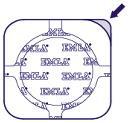
- 1. Make sure the skin surface to be anesthetized is clean and dry. Hold one of the corners of the aluminum foil protecting the plaster and bend it back. Then, hold the light beige-colored layer of the plaster at the same corner. Before proceeding, make sure the two layers at the corner of the plaster have been properly separated.
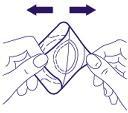
- 2. Pull and separate the two layers from each other, thus separating the adhesive surface from the protective foil, as shown in the drawing. Be careful not to touch the round white disc that contains the medicine.

- 3. Do not press the central part of the plaster. Pressing this part of the plaster may cause the medicine to leak under the adhesive layer and prevent the plaster from adhering properly to the skin. Press the edges of the plaster firmly to ensure good adhesion to the skin.
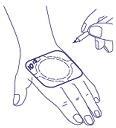
- 4. The time of application of the plaster to the skin can be written directly on the edge of the plaster. (A pen can be used for this purpose.)

- 5. Leave the plaster on for at least one hour (except for patients with atopic dermatitis, see "Warnings and precautions"). In children under 3 months, the plaster should not be left on for more than 1 hour.
- 6. After the application time has passed, remove the plaster from the skin.
Using on the skin before removing warts
- The medicine can be used in children and adolescents with a skin condition called "atopic dermatitis".
- The recommended dose depends on the child's age and is applied for 30 to 60 minutes (30 minutes if the patient has atopic dermatitis). A doctor, nurse, or pharmacist will tell the patient how many plasters to use.
Using more than the recommended dose of the medicine
If a dose of the medicine higher than that described in the leaflet or recommended by a doctor, pharmacist, or nurse is used, they should be informed immediately, even if there are no symptoms.
Symptoms that may occur after using too much of the medicine are listed below. These symptoms should not occur when using the medicine as recommended.
- A feeling of "emptiness" in the head or dizziness.
- Numbness or tingling of the skin around the mouth and tongue.
- Disturbances in taste perception.
- Blurred vision.
- Ringing in the ears.
- There is also a risk of acute methemoglobinemia (a problem related to the concentration of a blood pigment). The risk of its occurrence is higher if the patient is taking certain specific medicines. If this condition occurs, the skin becomes blue-gray due to insufficient oxygen in the blood.
In severe cases of overdose, the following symptoms may occur: seizures, decreased blood pressure, slow breathing, respiratory arrest, and abnormal heart rhythm. These symptoms can be life-threatening.
If you have any further doubts about using this medicine, consult a doctor, pharmacist, or nurse.
4. Possible side effects
Like all medicines, this medicine can cause side effects, although not everybody gets them.
If the patient experiences any of the following side effects or if they persist, they should contact their doctor or pharmacist immediately. They should tell their doctor about anything that makes them feel unwell while using the medicine.
A mild reaction may occur at the site of application of the medicine (pallor or redness of the skin, slight swelling, initial burning or itching sensation). These are normal reactions to the plaster and anesthetics, which disappear after a short time without the need for medical intervention.
If the patient experiences any worrying or unusual reactions or effects while using the medicine, they should stop using it and contact a doctor or pharmacist immediately.
Common(may affect up to 1 in 10 people):
- Transient local skin reactions (pallor, redness, swelling) at the site of application of the medicine.
Uncommon(may affect up to 1 in 100 people):
- Initial mild sensation of burning, itching, or warmth at the site of application of the medicine.
Rare(may affect up to 1 in 1000 people):
- Allergic reactions, which in rare cases can lead to anaphylactic shock (skin rash, swelling, fever, difficulty breathing, and fainting).
- Methemoglobinemia (a blood disorder).
- Minor pinpoint bleeding (petechiae) at the site of application of the medicine (especially in children with eczema after prolonged use of the medicine).
- Irritation of the eyes if they accidentally come into contact with the medicine during application to the skin.
Additional side effects in children
Methemoglobinemia, a blood disorder, which is more commonly observed in children, often in association with overdose in newborns and infants under 12 months of age.
Reporting side effects
If side effects occur, including any side effects not listed in this leaflet, the patient should inform their doctor, pharmacist, or nurse. Side effects can be reported directly to the Department of Post-Marketing Surveillance of Adverse Reactions to Medicinal Products, Medical Devices, and Biocidal Products, Al. Jerozolimskie 181C, 02-222 Warsaw, tel.: +48 22 49 21 301, fax: +48 22 49 21 309
Website: https://smz.ezdrowie.gov.pl.
Side effects can also be reported to the marketing authorization holder.
Reporting side effects will help to gather more information on the safety of the medicine.
5. How to store the medicine
Keep the medicine out of sight and reach of children.
Do not use this medicine after the expiry date stated on the packaging after "Expiry Date (EXP)". The expiry date refers to the last day of the month stated.
Do not store above 25°C.
Medicines should not be disposed of via wastewater or household waste. Ask your pharmacist how to dispose of medicines no longer required. This will help protect the environment.
6. Contents of the pack and other information
What the medicine contains
- The active substances of the medicine are lidocaine and prilocaine. One medicinal plaster with an area of approximately 10 cm² contains 25 mg of lidocaine and 25 mg of prilocaine.
- The other ingredients are: macrogolglycerol hydroxystearate, carbopol 974P, sodium hydroxide to adjust the pH to 8.7-9.7, purified water.
What the medicine looks like and contents of the pack
The medicine consists of a part that adheres to the skin and a protective foil. The part that adheres to the skin is light beige in color. In the center of the plaster, there is a round white disc containing the active substances and excipients. The rest of the plaster is covered with an acrylic adhesive.
Pack sizes
2 plasters, protected on one side with aluminum foil, in a cardboard box.
Marketing authorization holder
Aspen Pharma Trading Limited
3016 Lake Drive
Citywest Business Campus
Dublin 24, Ireland
Tel: 0048 221253376
Manufacturer
Recipharm Karlskoga AB
Bjorkbornsvagen 5
SE-691 33 Karlskoga
Sweden
Date of last revision of the leaflet: 03/2024
- Country of registration
- Active substance
- Prescription requiredYes
- ImporterGenepharm S.A. Pharmadox Healthcare Ltd. PharmaPath S.A.
- This information is for reference only and does not constitute medical advice. Always consult a licensed doctor before taking any medication. Oladoctor is not responsible for medical decisions based on this content.
- Alternatives to Profitadal
Alternatives to Profitadal in other countries
The best alternatives with the same active ingredient and therapeutic effect.
Alternative to Profitadal in Spain
Alternative to Profitadal in Ukraine
Online doctors for Profitadal
Discuss dosage, side effects, interactions, contraindications, and prescription renewal for Profitadal – subject to medical assessment and local rules.



